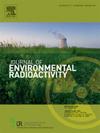Deployment of portable, modular gas samplers as part of an atmospheric tracer experiment
IF 1.9
3区 环境科学与生态学
Q3 ENVIRONMENTAL SCIENCES
引用次数: 0
Abstract
Underground nuclear explosions release noble gases into the atmosphere that can be detected to support international monitoring efforts. Atmospheric transport models help predict the movement of these gases over long distances, but struggle to predict the movement in the atmosphere local to the release. A field experiment was designed to monitor the movement of 127Xe within a 5-km radius. Four gas samplers were deployed as part of this experiment to collect atmospheric samples at various distances from the release point. These samples were then analyzed in a near-field lab using a NaI(Tl) detector and in an off-site lab using gamma-gamma coincidence and beta-gamma coincidence counting.
求助全文
约1分钟内获得全文
求助全文
来源期刊

Journal of environmental radioactivity
环境科学-环境科学
CiteScore
4.70
自引率
13.00%
发文量
209
审稿时长
73 days
期刊介绍:
The Journal of Environmental Radioactivity provides a coherent international forum for publication of original research or review papers on any aspect of the occurrence of radioactivity in natural systems.
Relevant subject areas range from applications of environmental radionuclides as mechanistic or timescale tracers of natural processes to assessments of the radioecological or radiological effects of ambient radioactivity. Papers deal with naturally occurring nuclides or with those created and released by man through nuclear weapons manufacture and testing, energy production, fuel-cycle technology, etc. Reports on radioactivity in the oceans, sediments, rivers, lakes, groundwaters, soils, atmosphere and all divisions of the biosphere are welcomed, but these should not simply be of a monitoring nature unless the data are particularly innovative.
 求助内容:
求助内容: 应助结果提醒方式:
应助结果提醒方式:


